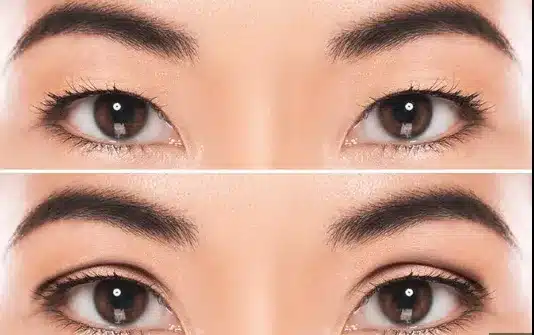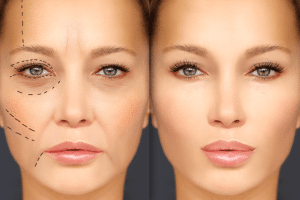Double eyelid surgery, also referred to as Asian blepharoplasty, is a cosmetic procedure aimed at creating a visible upper eyelid crease where none previously existed, commonly known as an eyelid fold. This surgical technique is particularly popular among individuals of Asian descent seeking to enhance the appearance of their eyes and achieve a more defined upper eyelid contour. By meticulously altering the eyelid’s anatomy, double eyelid surgery offers transformative results, accentuating the eyes and contributing to a more symmetrical and harmonious facial aesthetic.
What is double eyelid surgery?
The term “double eyelid” refers to a crease that appears when the eye is open, creating a visible separation between the upper eyelid and the underlying tissues. While some individuals naturally have this crease, others have a single eyelid, known as a monoid, where the skin of the upper eyelid covers the eyelashes without a visible crease.
Double eyelid surgery offers a solution for those who desire a more pronounced eyelid crease, as it helps to open up the eyes, make them appear larger, and provide a more alert and youthful appearance. This procedure is not only popular among individuals of Asian descent but also among people from various ethnic backgrounds who desire the aesthetic benefits it offers.
In this article, we will delve into the different types of double eyelid surgery, explore the step-by-step process of the procedure, discuss the benefits and risks associated with it, provide guidance on what to do before and after the surgery, and conclude with a summary.
Different Types of Double Eyelid Surgery
There are several techniques used in double eyelid surgery, and the choice of method depends on factors such as the patient’s anatomy, desired outcome, and the surgeon’s expertise. Here are three common types:
- Full Incision Method: This method involves making an incision along the desired crease line of the upper eyelid. Excess skin, fat, and muscle may be removed, and the tissues are reshaped to create a natural-looking double eyelid crease. This technique is suitable for individuals with excess skin or fat and can produce a well-defined eyelid crease.
- Partial Incision Method: In this technique, the incision is made only in the middle section of the eyelid, leaving the inner and outer portions untouched. This approach is suitable for individuals with less excess skin and is known for creating a softer and more subtle crease.
- Non-Incisional or Suture Method: This method involves creating a double eyelid crease using sutures. The surgeon makes tiny punctures along the desired crease line and inserts sutures to create the crease. This technique is less invasive, has a shorter recovery time, and may be suitable for individuals with minimal excess skin or fat.
The choice of technique will depend on the patient’s preferences, eyelid anatomy, and the surgeon’s recommendations during the consultation.
The Role of Prominent Surgeons in Double Eyelid Surgery
In the field of double eyelid surgery, prominent figures such as Dr. Kenneth Kim from the University of California, Los Angeles (UCLA) and Dr. Charles S. Lee from Stanford University have contributed significantly to advancing techniques and research. Their work in the area of Asian blepharoplasty, a specific form of double eyelid surgery, has garnered international recognition and shaped modern approaches to addressing diverse eyelid anatomy and patient preferences.
Additionally, companies like SonoBello and hospitals such as the Cleveland Clinic have emerged as leaders in providing specialized facilities and expertise for double eyelid surgery, catering to the growing demand for cosmetic enhancements in this area. Recent statistics reveal a notable rise in the popularity of double eyelid surgery, particularly among Asian populations seeking aesthetic modifications to their eyelid appearance.
According to data from the American Society of Plastic Surgeons (ASPS), there has been a consistent increase in the number of blepharoplasty procedures performed in recent years, with over 1.2 million surgeries conducted in the United States alone. This surge in demand underscores the cultural significance and evolving beauty standards associated with double eyelid surgery, highlighting the need for ongoing research and innovation to meet patient expectations and ensure safe and effective outcomes.
How Double Eyelid Surgery Gets Done Step by Step
Double eyelid surgery typically involves the following steps:
- Initial Consultation: You will meet with a plastic surgeon to discuss your goals, expectations, and medical history. The surgeon will examine your eyelids, evaluate your facial features, and determine the most suitable technique for you.
- Anesthesia: The surgery can be performed under local anesthesia with sedation or general anesthesia, depending on your comfort level and the surgeon’s recommendation.
- Incision: The surgeon will make incisions along the desired crease line of the upper eyelid. The specific technique used will depend on the chosen method, as discussed earlier.
- Tissue Adjustment: Excess skin, fat, or muscle may be removed or repositioned to create a natural-looking double eyelid crease. The surgeon carefully reshapes and redistributes the tissues to achieve the desired aesthetic outcome.
- Closure: The incisions are closed with sutures, and the surgeon may apply surgical tape or dressings to support the eyelids during the initial healing phase.
The duration of the surgery can vary depending on the complexity of the case, but it typically takes around one to two hours to complete.
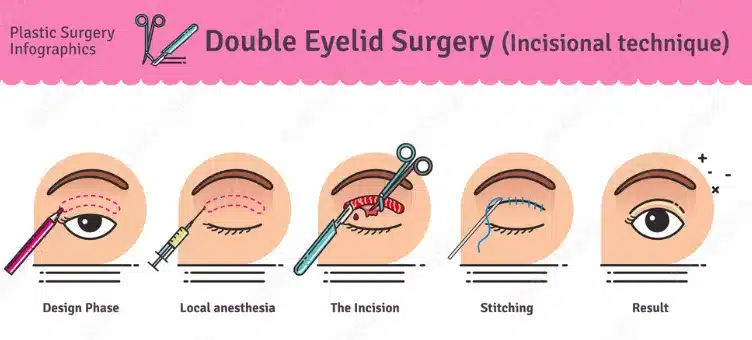
Benefits of Double Eyelid Surgery
Double eyelid surgery offers various benefits, which may include:
- Enhanced Eye Appearance: The creation of a double eyelid crease can make the eyes appear larger, brighter, and more defined, improving overall facial aesthetics.
- Improved Symmetry: Double eyelid surgery can address asymmetry and create a more balanced and harmonious look between the eyes.
- Youthful Appearance: By opening up the eyes, double eyelid surgery can provide a more youthful and refreshed appearance.
- Makeup Application: Having a double eyelid can make it easier to apply eye makeup, allowing for a wider range of styles and techniques.
- Increased Confidence: Many individuals report increased self-confidence and improved self-esteem after double eyelid surgery, as they feel more satisfied with their appearance.
It is important to note that the specific benefits may vary depending on individual circumstances, and it’s crucial to have realistic expectations and discuss your goals with a qualified plastic surgeon.
Eyelid surgery, also known as blepharoplasty, is a cosmetic procedure that focuses on improving the appearance and function of the eyelids. The eyes are often considered one of the face’s most prominent and expressive features, and eyelid surgery can enhance their overall aesthetic appeal while addressing functional issues such as drooping or sagging eyelids.
10 Risks of Double Eyelid Surgery
As with any surgical procedure, double eyelid surgery carries certain risks and potential complications, including:
- Infection: There is a risk of developing an infection at the incision site, although this is relatively rare.
- Bleeding: Excessive bleeding during or after the surgery is possible but uncommon. Surgeons take precautions to minimize this risk.
- Adverse Reaction to Anesthesia: General anesthesia or local anesthesia with sedation carries its own set of risks, such as allergic reactions, breathing difficulties, or adverse drug reactions. These risks are generally low but should be discussed with the anesthesiologist.
- Scarring: Although surgeons take great care to minimize scarring, some degree of scarring is inevitable. However, the incisions are typically well-concealed within the natural crease of the eyelid.
- Asymmetry: There is a slight risk of uneven or asymmetrical results, where one eyelid may appear different from the other. Skilled surgeons take measures to ensure symmetry but it can never be guaranteed perfectly.
It’s important to thoroughly discuss these risks and potential complications with your plastic surgeon during the consultation phase to make an informed decision.
This technique is best suited for those patients without excess skin but do have excess fat within their eyelids. Standford Medicine
What Should You Do Before and After Double Eyelid Surgery
Before double eyelid surgery, it’s essential to schedule a consultation with a qualified plastic surgeon to discuss your goals and medical history. Research different techniques and familiarize yourself with the procedure’s potential risks and recovery process. Follow pre-operative instructions provided by your surgeon, such as avoiding certain medications and arranging transportation for the day of surgery.
After the procedure, adhere strictly to post-operative instructions, including wound care and medication management. Attend all follow-up appointments to monitor your progress and address any concerns. Manage discomfort with prescribed medications and cold compresses and protect your eyes from sunlight and irritants. Be patient and allow time for swelling to subside and for the final results to develop, understanding that full healing and optimal outcomes may take several weeks to months.
Before the Surgery
Before undergoing double eyelid surgery, it is crucial to take certain preparatory steps, including:
Consultation
Schedule a consultation with a qualified plastic surgeon who specializes in eyelid surgery. During this meeting, discuss your goals, medical history, and any concerns you may have. The surgeon will conduct a thorough examination of your eyelids and provide personalized recommendations.
Medical Evaluation
Complete any necessary medical tests or evaluations as advised by your surgeon. This may include blood tests or ophthalmological examinations to ensure that you are in good health and a suitable candidate for the procedure.
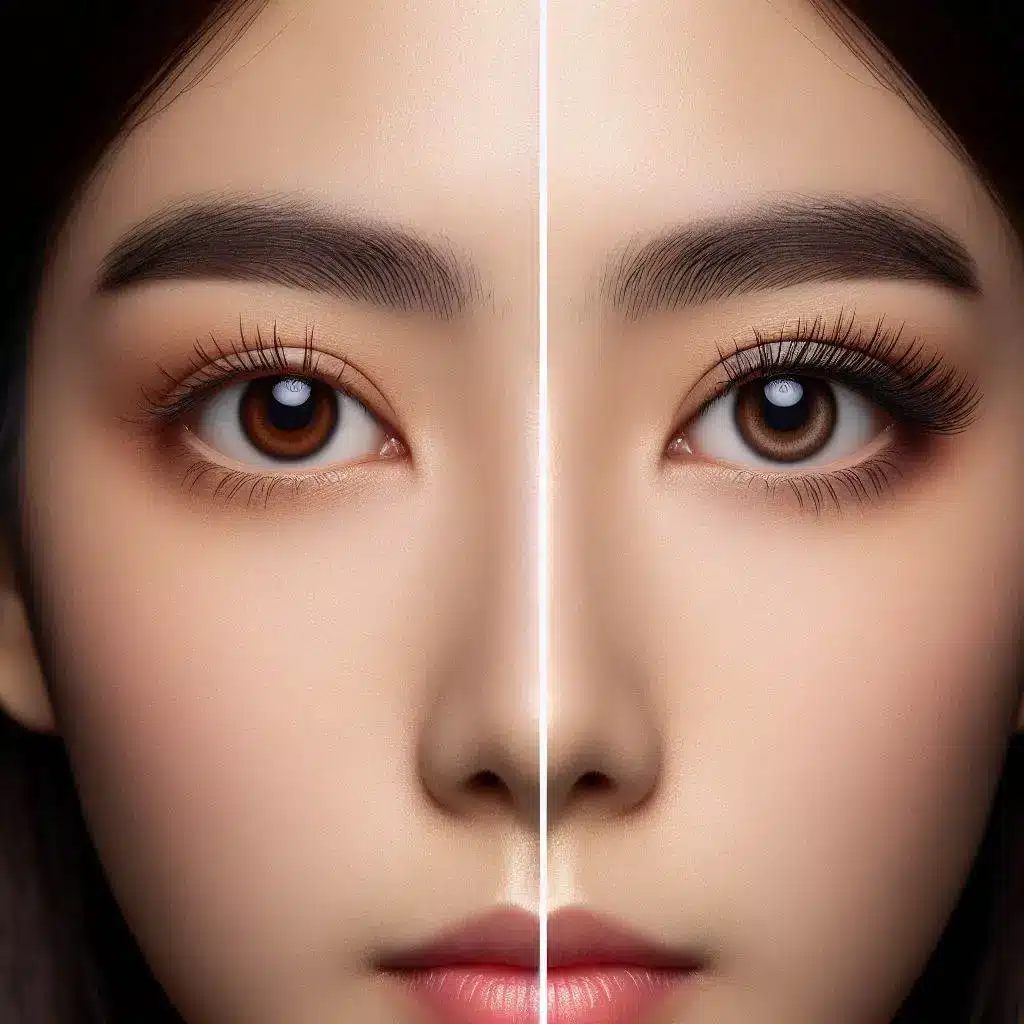
Quit Smoking
If you are a smoker, it is recommended to quit smoking at least a few weeks before the surgery, as smoking can impair the healing process and increase the risk of complications.
After the Surgery
After double eyelid surgery, proper care and attention are crucial for a smooth recovery. Here are some general guidelines to follow:
Deciding between a brow lift (Uroplasty) and eyelid surgery (blepharoplasty) hinges on your aesthetic goals, particularly regarding facial symmetry and the definition of the eyelid crease. Bioplasty elevates the eyebrows to refresh the upper face, while blepharoplasty corrects issues in the eyelids, enhancing the eye’s appearance and function. The choice significantly impacts facial harmony, making it crucial to understand each procedure’s benefits in achieving a balanced and rejuvenated look.
Follow Postoperative Instructions
Carefully adhere to the specific postoperative instructions provided by your surgeon. These may include information on wound care, medication usage, and limitations on activities.
Apply Cold Compresses
Applying cold compresses to the eyes can help reduce swelling and bruising. Use a clean cloth or an ice pack wrapped in a towel, and gently apply it to the eyes for short intervals as advised by your surgeon.
Take Prescribed Medications
Take any prescribed medications as directed by your surgeon, including pain relievers, antibiotics, or eye drops. Be sure to follow the recommended dosage and frequency.
Remember, every individual’s recovery experience can differ, and it’s important to communicate openly with your surgeon and seek their guidance throughout the healing process.
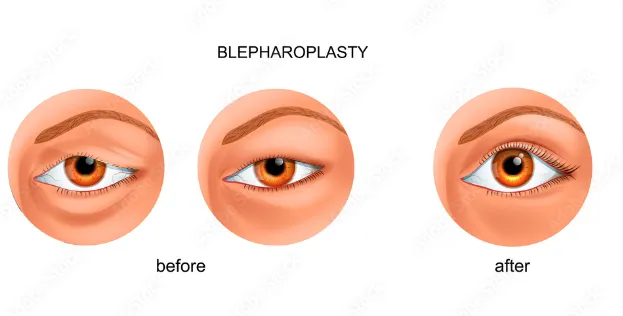
Summary
In conclusion, double eyelid surgery, also known as Asian blepharoplasty, offers individuals seeking aesthetic enhancement a transformative option to define and enhance the upper eyelid crease. Throughout the candidate assessment process, careful consideration of anatomical factors and individual preferences ensures tailored treatment plans that align with each patient’s desired outcomes. Following surgery, adherence to the recovery process and post-operative care instructions is crucial for facilitating optimal healing and minimizing potential complications.
The recovery process typically involves managing swelling and bruising, as well as avoiding strenuous activities to promote proper healing of the eyelid tissues. Overall, double eyelid surgery can yield lasting improvements in facial appearance and boost self-confidence when approached with thorough assessment, diligent recovery, and attentive post-operative care.
FAQs
1. Is double eyelid surgery permanent?
Double eyelid surgery provides long-lasting results, and the created crease typically remains stable over time. However, natural aging and tissue changes can affect the eyelids’ appearance over the years.
2. How long does it take to recover from double eyelid surgery?
The initial recovery period for double eyelid surgery is usually around one to two weeks, during which swelling and bruising gradually subside. However, it may take several weeks or months for the final results to manifest fully and for the incision lines to fade.
3. What are the different techniques used in double eyelid surgery?
There are various techniques for double eyelid surgery, including the full-incision method, partial-incision method, and non-incisional method. The choice of technique depends on factors such as the patient’s anatomy, desired outcome, and surgeon’s preference.
4. Is double eyelid surgery permanent?
Double eyelid surgery typically provides long-lasting results, but the permanence can vary depending on factors such as individual healing, aging, and lifestyle factors. While the eyelid crease created during surgery is intended to be permanent, changes in the eyelid structure over time may necessitate revision surgery in some cases.
5. What is the recovery like after double eyelid surgery?
Recovery from double eyelid surgery involves some swelling, bruising, and discomfort, which typically subside within a few weeks. Patients are advised to avoid strenuous activities and follow post-operative care instructions provided by their surgeon to ensure optimal healing.
https://med.stanford.edu/cosmeticsurgery/aestheticservices/face/asian-double-eyelid.html
